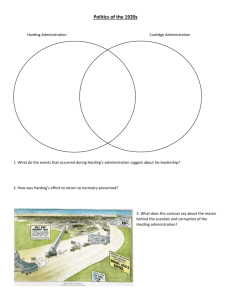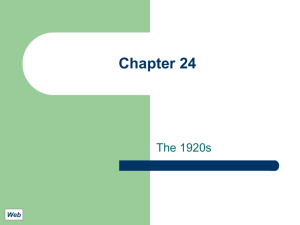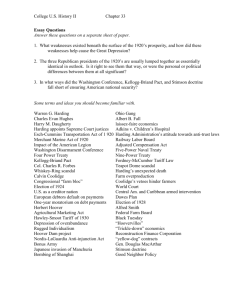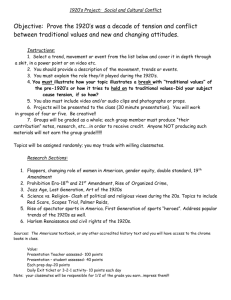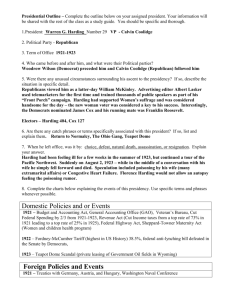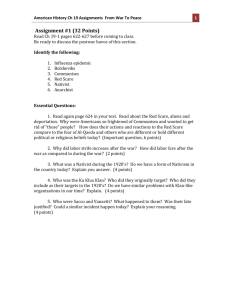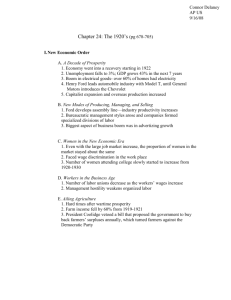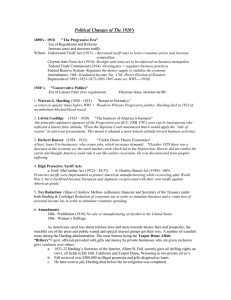enduring understanding: the 1920s
advertisement
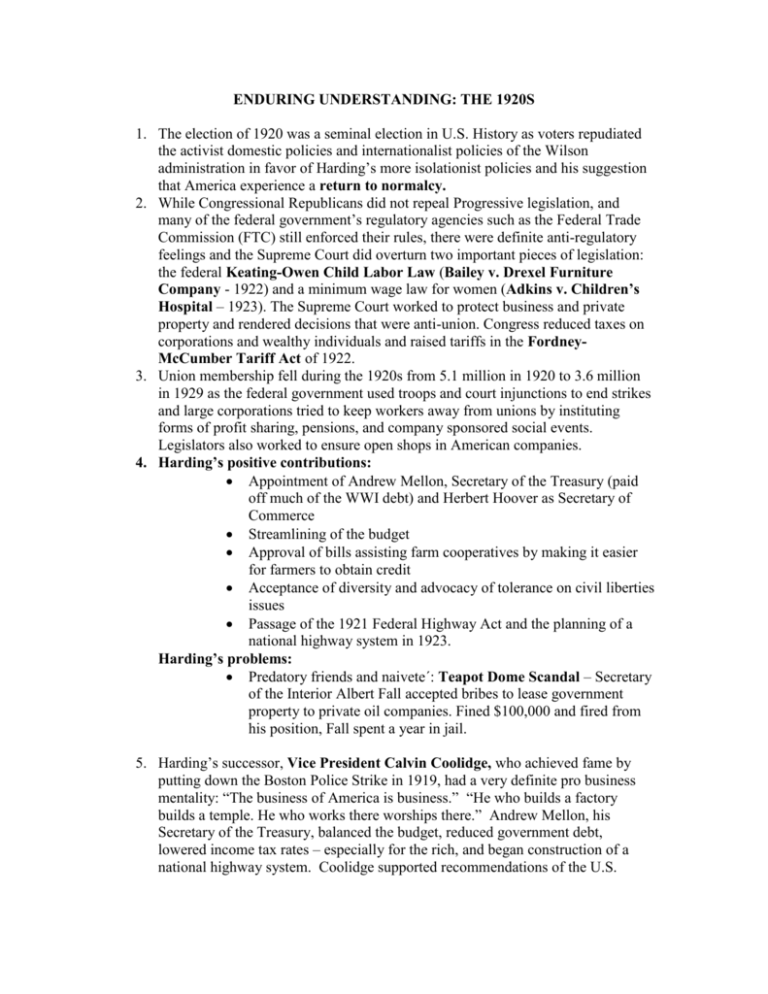
ENDURING UNDERSTANDING: THE 1920S 1. The election of 1920 was a seminal election in U.S. History as voters repudiated the activist domestic policies and internationalist policies of the Wilson administration in favor of Harding’s more isolationist policies and his suggestion that America experience a return to normalcy. 2. While Congressional Republicans did not repeal Progressive legislation, and many of the federal government’s regulatory agencies such as the Federal Trade Commission (FTC) still enforced their rules, there were definite anti-regulatory feelings and the Supreme Court did overturn two important pieces of legislation: the federal Keating-Owen Child Labor Law (Bailey v. Drexel Furniture Company - 1922) and a minimum wage law for women (Adkins v. Children’s Hospital – 1923). The Supreme Court worked to protect business and private property and rendered decisions that were anti-union. Congress reduced taxes on corporations and wealthy individuals and raised tariffs in the FordneyMcCumber Tariff Act of 1922. 3. Union membership fell during the 1920s from 5.1 million in 1920 to 3.6 million in 1929 as the federal government used troops and court injunctions to end strikes and large corporations tried to keep workers away from unions by instituting forms of profit sharing, pensions, and company sponsored social events. Legislators also worked to ensure open shops in American companies. 4. Harding’s positive contributions: Appointment of Andrew Mellon, Secretary of the Treasury (paid off much of the WWI debt) and Herbert Hoover as Secretary of Commerce Streamlining of the budget Approval of bills assisting farm cooperatives by making it easier for farmers to obtain credit Acceptance of diversity and advocacy of tolerance on civil liberties issues Passage of the 1921 Federal Highway Act and the planning of a national highway system in 1923. Harding’s problems: Predatory friends and naivete´: Teapot Dome Scandal – Secretary of the Interior Albert Fall accepted bribes to lease government property to private oil companies. Fined $100,000 and fired from his position, Fall spent a year in jail. 5. Harding’s successor, Vice President Calvin Coolidge, who achieved fame by putting down the Boston Police Strike in 1919, had a very definite pro business mentality: “The business of America is business.” “He who builds a factory builds a temple. He who works there worships there.” Andrew Mellon, his Secretary of the Treasury, balanced the budget, reduced government debt, lowered income tax rates – especially for the rich, and began construction of a national highway system. Coolidge supported recommendations of the U.S. Chamber of Commerce and vetoed the McNary-Haugen Farm Bills which would have established government price supports for staple crops. 6. While reform did not end at the national level, most reform in the 1920s occurred at the state and local levels where reformers were in training (though they did not know it at the time) for the New Deal of the 1930s. 7. Women were given the right to vote in 1920 by the 19th amendment and worked through voluntary organizations to pressure Congress on such matters as birth control, peace, education, Indian Affairs, and opposition to lynching. They voted at about the same low rates as male voters. The League of Women Voters which grew out of the National American Woman Suffrage Association lobbied for issues of interest to women and integrated women into politics. The National Woman’s Party, however, stressed female solidarity in its quest for equal rights for women. Native Americans were given citizenship and voting rights in 1924. 8. The decade of the 1920s was a consumer’s paradise driven by the low prices and widespread availability of the automobile and all the new industries spawned by the demand for cars. Between 1919 and 1929 the G.N.P. swelled by 40%, wages and salaries increased slightly, and cost of living remained stable. Therefore Americans had more purchasing power. New technologies and products included: automobiles, electricity, electric vacuum cleaners, electric toasters, radios (KDKA in Pittsburgh), washing machines, refrigerators/ice boxes, widespread indoor plumbing, canned foods, and movies. Advertising contributed to the demand for products. 9. Demographic Changes: Continuing urbanization: in 1920 more Americans lived in urban than rural areas Explosive growth in Miami and San Diego Movement of people to cities such as Detroit, Birmingham, and Houston because of manufacturing and industrialization African Americans accelerated a trend that began before WWI, moving to the Northern urban centers in search of jobs. Because of new circumstances, race riots, and threats, many African- Americans turned to organizations that glorified Black Nationalism such as the Universal Negro Improvement Association of Marcus Garvey. Because the restrictive immigration acts of 1921 and 1924 did not impact Mexicans, many Mexicans came over the borders into southwestern and western cities crowded into barrios. Because of a shift from sugar to coffee production in Puerto Rico, many Puerto Ricans migrated to New York City where they formed barrios in parts of Brooklyn and Manhattan. Suburban growth accelerated as urban growth continued. Suburban growth was fueled by the automobile’s access to areas farther from the cities and trolleys and street cars. Most suburbs were middle and upper class “bedroom” communities. 10. Social Changes: Birth rates dropped (availability of birth control) Divorce rate rose New technologies eliminated the need for servants, however women began to spend as much, if not more time on domestic responsibilities Vitamins were “discovered” Advertising pushed cleanliness – clothes, dental health, and personal hygiene High school and college enrollment skyrocketed More rest and better health made Americans live longer Youth culture extolled, but conditions for the elderly worsened The line between inappropriate and acceptable behavior blurred and Sigmund Freud’s theories became the rage. Birth control advocate, Margaret Sanger, gained a large following. Sexual overtones became more pronounced. Women continued to stream into the labor force in such positions as teachers, nurses, bookkeepers, typists, office clerks, hairdressers, and waitresses. The proportions of black women in the work force were twice that of white women. Alice Paul, leader of the National Women’s Party, supported an Equal Rights Amendment to the Constitution in 1923. Signs of women’s sexual freedom: short skirts, bobbed hair, smoking and drinking in public, and pre-marital sex. Movies and spectator sports (baseball, football, tennis, golf) became popular, sports heroes were glorified, Charles A. Lindbergh who flew solo non-stop across the Atlantic became a hero as much for his small town values and modesty as for his daring feat. The Volstead Act (18th amendment) brought about prohibition spawned organized crime and eventually was repealed because of its failure to enforce morality. Literary figures (F.Scott Fitzgerald, Sinclair Lewis, Ernest Hemingway) became disillusioned and were known as the “lost generation.” They produced works of biting satire that criticized America and its values. The Harlem Renaissance’s writers extolled the “new Negro” who was proud of his African heritage and rejected the blending of black and white cultures. The question was raised as to whether African Americans were black men first or Americans first. Jazz, a musical trend that grew out of black urban culture, became popular for blacks and whites. Georgia O’Keefe and John Marin tried to create a uniquely American style of painting. Frank Lloyd Wright’s prairie style architecture reflected the splendor of the American landscape and American skyscrapers drew the attention of the world. 11. Conflicts: While on the surface all looked well, underneath there were many conflicts. Below is a partial list: Urban v. rural White v. black Immigrant v. white native born Americans Youth v. the older generation Rising prosperity for some v. declining prosperity for others Labor v. management Religion v. the new science Internationalism v. isolationism Wet v. dry Traditional v. modern 12. Underlying causes of the Great Depression: While the economy looked good to the casual observer, there were many problems which began to snowball. Below is a partial list. An uneven distribution of income A trend toward oligopolies (fewer than 15 companies controlling an industry) as business after business merged Buying stocks on margin (credit) with only a small down payment. The broker provided a broker’s loan that was expected to be repaid by the buyer when the stock went up in value as stock prices continued to rise Stock prices increasing exponentially while salaries rose slightly or remained flat. Overproduction and under consumption International trade problems stemming from American investors not investing their money in Europe, making it difficult for Europeans to repay their debts from World War I. European nations raised their tariffs, we raised ours, and a tariff war ensued. Poor regulation of banking practices and stock market speculation



